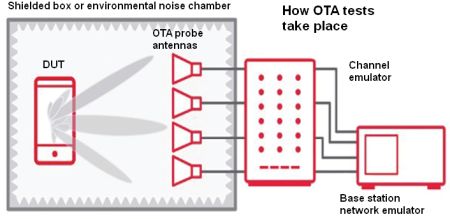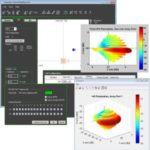Specs for 5G NR release-15 have been finalized and plans call for product introductions this year.
Sheri DeTomasi | Keysight Technologies, Inc.
The development of 5G standards and their commercial rollout appears to be on a fast track. Mobile operators and network equipment makers are conducting field trials and the first smartphones are expected out this year. Predictions are that nearly half of global businesses are either already deploying 5G networks or plan to deploy them within the next 12 months.

5G products and components require testing through the ecosystem, including modems, antennas, sub-systems, and fully assembled end-user devices. Devices and base stations will follow with a similar testing workflow: research and development (R&D), design validation, conformance, and acceptance testing for devices.
Manufacturers must follow many rules and regulations when bringing mobile wireless communications products to market. Testing takes place throughout the product lifecycle to ensure the end product meets Third Generation Partnership Project (3GPP) specifications and provides the quality of service mobile operators aim to deliver.
Conformance tests are required by most vendors before release of a device into the market. Conformance tests are a key requirement and involve connecting a device to a wireless test system and performing the required 3GPP tests:
Radio frequency (RF) transmission and reception performance – minimum level of signal quality
Demodulation – data throughput performance
Radio resource management (RRM) – initial access, handover, and mobility
Signaling – upper layer signaling procedures.

5G NR products can operate in two frequency ranges – frequency range 1 (FR1: 410 MHz to 7.125 GHz) or frequency range 2 (FR2: 24.25 to 52.6 GHz), or both FR1 and FR2. Testing in FR1 below 3.5 GHz is firmly established with well-understood test methods and associated uncertainties.
Given that FR1 below 7 GHz operates under the same characteristics, tests in FR1 will resemble those of LTE with most conformance tests employing a cable connected to the device; antenna qualities and multiple input multiple output (MIMO) performance will be completed over-the-air (OTA).
FR2 at millimeter-wave (mmWave) frequencies adds a completely new twist on testing because all measurements in FR2 will be tested OTA.
Third-party test labs perform conformance tests to determine if a UE is compliant. These tests are expensive, so most companies conduct their own pre-conformance tests before engaging an independent lab. Currently, these tests are still in development and will be defined over the next year for different use cases.
5G NR introduces many new features that make testing more complex. Higher-frequency operation, wider channel bandwidths, flexible waveform structure, and the rising number of test cases that must be validated all complicate test design. For the most part, the testing of designs under 6 GHz in FR1 resembles that of LTE. In FR1, the key challenges lie in testing designs operating between 3.5 GHz and 7.125 GHz that use wider bandwidths and massive MIMO, and designs operating in FR2 because they require OTA test methods. OTA introduces many challenges that UE and base station designers haven’t seen and has big implications for the test environment.
User Equipment Test Challenges: 5G NR must accommodate many different usage scenarios from high throughput to low packet size, to low latencies with high reliability. The 5G NR physical layer was given the flexibility to support such a wide variety of use cases, changing the way signals are created and operate. In addition, there are seven different system architecture options and dual connectivity with 4G LTE. Testing must cover the many different use cases.
Furthermore, testing involves signaling and full end-to-end performance with real-world impairments like excessive path loss, multi-path fading, and delay spread. Wringing out these functions requires an OTA test solution that can emulate base station protocols and channel conditions.
The drastically higher number of test cases that must be validated for conformance and device acceptance testing dramatically lengthens test times. To minimize the risk of parallel development, ensure you are testing to the latest specifications and getting regular 5G NR test software updates to help meet evolving 5G NR requirements.
Base Station Test Challenges: The active nature of 5G beam steering and beamforming requires validation in an OTA setting. Key aspects such as antenna gain, side lobe, and null depth for the full range of 5G frequencies and bandwidths can severely impact system performance. In particular, 3D antenna beam measurements introduce many complexities into the test.
While path loss and signal impairments were not a big issue at 3.5 GHz and below, such phenomena are problematic at mmWave frequencies. Therefore, test solutions for mmWave frequencies must accommodate higher frequencies with wider channel bandwidths and also address higher path loss at mmWave frequencies. To that end, a test solution must have an adequate signal-to-noise ratio (SNR) to accurately detect and demodulate 5G signals.
When testing transmitters, high SNR in the test analyzer is critical for accurate error vector magnitude (EVM) and adjacent channel leakage ratio (ACLR) measurements, and achieving higher SNR becomes even more of a challenge for those testing at mmWave frequencies. The use of signal generators with higher output power per EVM and ACLR becomes important for testing receivers. In addition, it is also critical that a system-level calibration correct for system-level phase and magnitude shifts over the bandwidth of the measurement.

Meanwhile, 5G conformance tests are key milestones in the product lifecycle but remain incomplete. Many performance and RMM tests are still being defined, and test cases specifications for OTA test have yet to be specified. However, the most relevant test cases for RAN5 are expected by mid-2019. This development will help phase in new capabilities in new products and limit risks.
In addition to updating 5G NR release-15, 3GPP has already started work on release-16. This covers new types of services, devices, deployment models, and spectrum bands. The emphasis is on ultra-reliable low-latency communications (URLLC) enhancements for the industrial internet of things (IIoT), utilization of unlicensed bands, vehicle-to-everything communications (V2X), and UE positioning and power efficiency.
However, incomplete and evolving targets are pressuring developers who need to ensure their designs and tests are flexible enough to handle future requirements. Designs and test systems must scale to new higher frequency bands, potentially with higher channel bandwidths, and support lower latency and co-existence with unlicensed bands.
Given that 5G NR Release-15 is frozen, are we at the 5G tipping point? It is fair to say we’re on the precipice: We are at a point where specifications are finalized for 5G NR release-15 and designs are planned for introduction in 2019.
But is it a point of no return? No.
Most vendors working on 5G NR are planning to phase-in their 5G capabilities. Initial releases such as dual-connectivity mobile phones will rely heavily on 4G for critical applications and use 5G for supplemental high-speed downloads. 5G NR Release-15 focuses on specifying the underlying foundation for the flexible air interface and enables the enhanced mobile broadband (eMBB) use case for high data throughput. These capabilities are highly focused, giving the first 5G products greater leeway to withstand a rocky start.
The real test for 5G products is farther down the road when critical applications that have higher consequences are introduced. It will be important for companies developing 5G products to engage with a test partner that has been working with leaders across the wireless ecosystem and has already faced most of the difficult problems involved in verifying compliance and capability.





Leave a Reply
You must be logged in to post a comment.